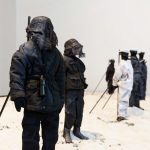THERE IS NO CESSATION
Introduction by Lotte Laub
A historical photograph gives a lateral view of two rows of human figures. They are wearing different uniforms and are unusually detailed, kitted out with accessories, including satchels and water bottles. They are propped up, if not impaled, by rods that appear to be wooden or metal poles. The mood is apocalyptic, as if the figures were waiting for something overpoweringly destructive to occur. The scene is desolate and empty, while the sandy ground conveys the idea of an ‘end-time’ that will threaten human existence. Presented for the first time in When I See the Future, I Close my Eyes: Chapter II, an exhibition curated by Anthony Downey, this is the mise-en-scene that forms the photograph-cum-diaroma that constitutes Heba Y. Amin’s latest work, Atom Elegy (2022).
The diorama of this tableau has been positioned in front of the original photographic image so that the figures are looking at the projected image of imminent destruction. Viewed from the side, the arrangement of mannequins corresponds to the perspectives they assume in the photograph: both mannequins and figures in the image stare in the same direction. Named after a poem written by Yvan Goll, in 1942, in which he glorified nuclear power as a technological achievement, Atom Elegy confronts the utopian promise of an ‘age of nuclear power’ and its legacies. Following the detonation of atomic bombs over Hiroshima and Nagasaki, on 6th and 9th of August 1945, Goll turned his laudatory poem into a lament that was later published in 1946.[1] The manuscript, which is discussed in this volume by Jürgen Kaumkötter, is housed in the literary archive at the Center for Persecuted Arts in Solingen, and the distinctions between the 1942 and 1946 texts became, in part, one of the starting points for Amin’s installation. Scrutinising the promise of emerging and new technologies, alongside their transformation into tools that demonstrate power, Atom Elegy investigates the historical events surrounding how, in the early 1960s, France carried out nuclear tests in the Algerian desert south of the Reggane Oasis. Corresponding to the colours of the national flag of France, the experiments were called ‘Gerboise Bleue,’ ‘Blanche,’ and ‘Rouge.’ The first test is said to have been four times more powerful than the atom bomb dropped on Hiroshima, and the figures in the historical photograph outlined above are the dummies that were used to test its impact. More specifically, the image shows the moment before the catastrophe of a nuclear detonation; the moment of anticipation and alertness. By creating doppelgangers of these figures in miniature, Heba Y. Amin retrospectively encourages a participative approach to the events, one that brings together the exhibition space, the work in question, and sense of anticipation. We are encouraged to look again at this scene, but, crucially, through a gaze that is retrospectively recuperating the original act of ‘looking.’ Photography, as it does throughout Amin’s practice, has a clear military role in the exercise of power, a point made all the more pertinent in Atom Elegy. Not only is photography used as an instrument to document destruction, it is part of the destruction.

The image, which is accessible through the context of a three-dimensional diorama, ensures that the figures can be viewed from several angles. In positioning these figures so that they look towards the projection, their role is changed: they are no longer merely objects of observation, as in the photograph, but assume agency in their own act of ‘looking.’ This draws our attention to how such acts are often ignored in official discourses. Survivors of the original nuclear tests, for example, have not been compensated by France and remain unheard as witnesses of this “surpassing disaster.” This latter phrase draws upon the work of the artist and thinker Jalal Toufic, when he speaks of “the withdrawal of tradition past a surpassing disaster,” that is, destruction resulting from war, genocide, colonial occupation and other violent interventions.[2] For Toufic, these processes not only involve material destruction but immaterial destruction, too: even if books, paintings, libraries, and museums survive or are reproduced or reconstructed, their immaterial value – their future potential as artefact and ideas – remains withdrawn under the conditions of disaster. The difficulty of reconnecting with one’s own tradition in such circumstances is not only related to the fact of immaterial withdrawal but also the lineage of tradition which is at risk of being lost to obscurity.



